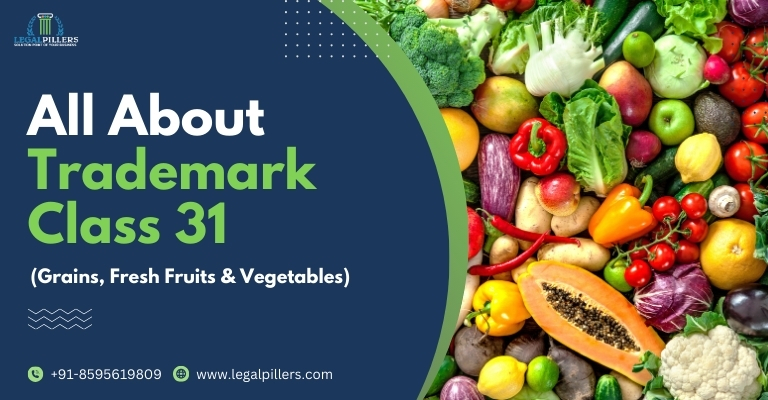
Table of Contents
All About Trademark Class 31
Trademark Class 31 is a specific category used in the classification of goods and services for trademark registration. In this class, goods related to agriculture and horticulture are categorized. It includes products such as live animals, fresh fruits and vegetables, seeds, grains, and various agricultural and gardening products. If you want to register a trademark for goods within this category, you have to file under Class 31 to protect your brand in the context of agricultural and horticultural products.
Important goods included in Trademark Class 31
Trademark class 31 mainly includes land and sea products not being subjected to any form of preparation for consumption, live animals and plants, and foodstuffs for animals. The goods included in this class of trademark are as given below-
- Unprocessed cereals
- Fresh fruits and vegetables, even after washing or waxing
- Plant residue
- Unprocessed algae
- Unsawn timber
- Fertilized eggs for hatching
- Fresh mushrooms and truffles
- Litter for animals, for instance, aromatic sand, sanded paper for pets
Goods does not included in Trademark Class 31
- Cultures of microorganisms and leeches for medical purposes (included in class 5).
- Dietary supplements for animals and medicated animal fees (included in class 5)
- Semi-worked woods (included in class 19)
- Artificial fishing bait (included in class 28)
- Rice (included in class 30)
- Tobacco (included in class 34)
List of popular examples of Trademark Class 31
- Pedigree: Dog food, food for animals, birds and fish, bones for dogs, etc.
- Drools: Foodstuffs for animals
- Whispering Homes: Dried plants for decorating purposes
- Interflora: Natural plants and flowers
- Krishidhan seeds: All kinds of seeds
List of goods classified under Trademark Class 31
A
- Algae for human or animal consumption or seaweed for human or animal consumption
- Algarovilla for animal consumption
- Almonds [fruits]
- Aloe vera plants
- Anchovy, live
- Animal foodstuffs
- Animal fattening preparations or livestock fattening preparations
- Aromatic sand for pets [litter]
- Arrangements of fresh fruit
- Artichokes, fresh
B
- Bagasses of cane [raw material]
- Barley*
- Beans, fresh
- Beet, fresh
- Berries, fresh
- Beverages for pets
- Birch sauna whisks
- Bird food
- Bran
- Bran mash for animal consumption
- Bred stock
- Buckwheat, unprocessed
- By-products of the processing of cereals, for animal consumption/ residual products of cereals for animal consumption
C
- Cannabis plants
- Cannabis, unprocessed
- Catnip
- Cereal seeds, unprocessed
- Chestnuts, fresh
- Chicory roots
- Chicory, fresh
- Christmas trees*
- Citrus fruit, fresh
- Cocoa beans, raw
- Coconut shell
- Coconuts
- Coffee fruit, unprocessed
- Copra
- Crayfish, live
- Crustaceans, live
- Cucumbers, fresh
- Cuttle bones for birds
D
- Distillery waste for animal consumption
- Dog biscuits
- Draff
E
- Edible chews for animals
- Edible flower, fresh
- Edible insects, live
- Edible linseed/ flaxseed, unprocessed
- Edible sesame, unprocessed
- Eggs for hatching, fertilized
F
- Fish spawn
- Fish, live
- Fish meal for animal consumption
- Fishing bait, live
- Flax meal [fodder]
- Flower bulbs
- Flowers, natural
- Flowers, dried, for decoration
- Fodder/ cattle food, or forage
- Freeze-dried fishing bait
- Fruit, fresh
- Fruit residue [marc] or marc
G
- Garden herbs, fresh
- Garlic, fresh
- Ginger, fresh
- Grains [cereals]
- Grains for animal consumption
- Grapes, fresh
- Groats for poultry
H
- Hay
- Hazelnuts, fresh
- Hemp seeds, unprocessed
- Herrings, live
- Hop cones
- Hops
J
- Juniper berries
K
- Koi carp, live
- Kola nuts or cola nuts
L
- Leeks, fresh
- Lemons, fresh
- Lentils, fresh
- Lettuce, fresh
- Lime for animal forage
- Linseed for animal consumption/ flaxseed for animal consumption
- Linseed meal for animal consumption or flaxseed meal for animal consumption
- Litter for animals
- Litter peat
- Live animals
- Lobsters, live
- Locust beans, raw
M
- Maize
- Maize cake for cattle
- Malt for brewing and distilling
- Mash for fattening livestock
- Meal for animals
- Menagerie animals
- Mushroom spawn for propagation
- Mushrooms, fresh
- Mussels, live
N
- Nettles
- Nuts, unprocessed
O
- Oats
- Oil cake or cattle cake
- Olives, fresh
- Onions, fresh
- Oranges, fresh
- Oysters, live
P
- Palm trees
- Palms [leaves of the palm tree]
- Peanut meal for animals
- Peanut cake for animals
- Peanuts, fresh
- Peas, fresh
- Peppers [plants]
- Pet food
- Pine cones
- Plants
- Plants, dried, for decoration
- Pollen [raw material]
- Potatoes, fresh
- Poultry, live
- Preparations for egg-laying poultry
Q
- Quinoa, unprocessed
R
- Rape cake for cattle
- Raw barks
- Residue in a still after distillation
- Rhubarb, fresh
- Rice meal for forage
- Rice, unprocessed
- Rose bushes
- Rough cork
- Rye
S
- Salmon, live
- Salt for cattle
- Sand for pet toilets
- Sanded paper for pets [litter]
- Sardines, live
- Sea-cucumbers, live
- Seed germ for botanical purposes
- Seedlings
- Seeds for planting or plant seeds
- Shellfish, live
- Shrubs and bushes
- Silkworm eggs
- Silkworms
- Small spelt, unprocessed
- Soya beans, fresh
- Spelt, unprocessed
- Spinach, fresh
- Spiny lobsters, live
- Squash seeds, unprocessed
- Squashes, fresh
- Stall food for animals
- Straw mulch
- Straw litter
- Straw [forage]
- Strengthening animal forage
- Sugarcane
T
- Trees
- Truffles, fresh
- Trunks of trees
- Tuna, live
- Turf, natural, or sod
U
- Undressed timber
- Unprocessed sweet corn ears [husked or unhusked]
- Unsawn timber
V
- Vegetable marrows, fresh
- Vegetables, fresh
- Vine plants
W
- Wheat
- Wheat germ for animal consumption
- Wood chips for the manufacture of wood pulp
- Wood shavings for animal bedding
- Wreaths of natural flowers
Y
- Yeast for animal consumption
Conclusion
Trademark Class 31 is a designated category within the Nice Classification system for trademark registration. It primarily covers agricultural and horticultural products, including live animals, fresh produce, seeds, and various farming and gardening items. If you’re involved in the agriculture or horticulture industry and want to protect your brand associated with these products, filing for trademark registration in Class 31 is essential to safeguard your intellectual property rights in this specific area.
At LegalPillers, we are here to help you for reducing the complexities of the classification & registration of trademarks and ensure that your band has been safeguarded within this trademark class. Choose LegalPillers as your trusted partner for classifying & registering your trademark under this class.
FAQs about Trademark Class 31
What is Trademark Class 31?
● Trademark Class 31 is a specific category used for trademark registration that encompasses various agricultural and horticultural products.
What types of products fall under Class 31?
● Class 31 includes products related to agriculture and horticulture, such as live animals, fresh fruits and vegetables, seeds, grains, and farming and gardening items.
Can I trademark the name of my agricultural product under Class 31?
● Yes, you can trademark the name of your agricultural product under Class 31 to protect your brand in the context of agricultural goods.
Do I need to use Class 31 to register a trademark for a farming equipment company?
● No, farming equipment typically falls under classes such as Class 7 (machinery) or Class 8 (hand tools). Class 31 is specifically for agricultural products.
Are seeds and plant varieties included in Class 31?
● Yes, seeds and plant varieties are included in Class 31.
Can I trademark the name of my farm or nursery under this class?
● Yes, you can trademark the name of your farm or nursery under Class 31 to protect your brand in the agricultural context.
Is live poultry included in Class 31?
● Yes, live poultry is included in Class 31.
Does this class cover processed food products?
● Processed food products are not typically covered under Class 31; they may belong to other classes, such as Class 29 or Class 30, depending on the nature of the product.
What is the purpose of classifying trademarks into different classes?
● The classification system helps organize trademarks into specific categories, making it easier for businesses and trademark offices to identify and register trademarks for similar goods and services.
Can I register a trademark in multiple classes?
● Yes, you can register a trademark in multiple classes if your brand is associated with goods or services that belong to different categories.
How do I determine if my product fits into Class 31?
● You should consult the official classification system, often provided by your Country’s trademark office, or seek legal advice to determine the appropriate class for your product.
What are the benefits of registering a trademark in Class 31?
● Registering a trademark in Class 31 protects your brand in the agricultural and horticultural industry, preventing others from using a similar mark for similar products.
Can someone else use a similar trademark in a different class?
● Yes, someone else can use a similar trademark in a different class if it doesn’t create confusion or conflict with your registered mark in Class 31.
Do I need to provide proof of use for a Class 31 trademark registration?
● The requirements for proof of use may vary by jurisdiction, but generally, you may need to demonstrate the use of the trademark for the registered goods or services.
What is the registration process for a Class 31 trademark?
● The registration process involves filing an application with the relevant trademark office, which will review and assess the application before granting or denying registration.
Can I register a trademark for both Class 31 and another class simultaneously?
● Yes, you can register a trademark for multiple classes simultaneously if your brand is associated with goods or services in different categories.
Can I trademark a brand name for a new type of agricultural product?
● Yes, you can trademark a brand name for a new agricultural product if it meets the criteria for trademark registration and is not already used by others.
Are international trademarks classified the same way as in my country?
● International trademarks are classified using the Nice Classification system, which is widely accepted and used globally. However, local variations may exist.
How long does a trademark registration in Class 31 last?
● The duration of trademark registration varies by country but is typically renewable every 10 years.
What should I do if someone infringes on my Class 31 trademark rights?
● If someone infringes on your trademark rights in Class 31, you should consult legal counsel to take appropriate legal actions, such as sending cease and desist letters or pursuing litigation to protect your brand.



Leave a Reply